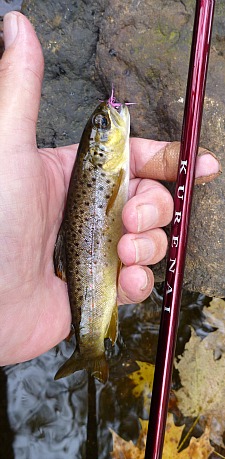Seiryu-Tenkara-Keiryu Continuum Part I
The Seiryu-Tenkara-Keiryu Continuum is like the light spectrum - an unbroken range of rod actions from the softest to the stiffest. And just as colors gradually change from red to orange to yellow, etc., rod actions gradually change from seiryu to tenkara to keiryu. There are no clear lines separating them.
A few people may have been a bit surprised when I posted the photo below, showing the way that the Daiwa Sagiri 39MC and the Tenkara USA Ayu bend under the weight of 10 pennies. More than anything else, I think this photo puts to rest the argument that you need to have a "tenkara rod" for tenkara fishing. The Tenkara USA Ayu was sold as a tenkara rod. The Daiwa Sagiri wasn't. Does it matter? Not in the least.
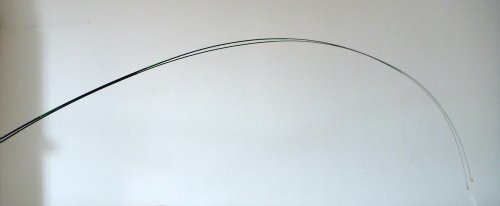
There are several different styles of fishing in Japan that utilize telescopic rods. This essay will take a very brief look at seiryu, tenkara and keiryu rods, which I will call the Seiryu-Tenkara-Keiryu Continuum. Tenkara rods, as most readers will already know, are designed to cast an unweighted fly with a light line. In Japan, both keiryu and seiryu rods are generally (but not exclusively) used for bait fishing. However, that does not mean they cannot cast a tenkara line. They can, and they can do so very well.
In general, seiryu rods are pretty soft and keiryu rods are pretty stiff. The photo below shows a keiryu rod, two tenkara rods and a seiryu rod. The stiffer tenkara rod is a 7:3 rod designed for level or tapered lines. The softer tenkara rod is a 5:5 rod designed for level lines.
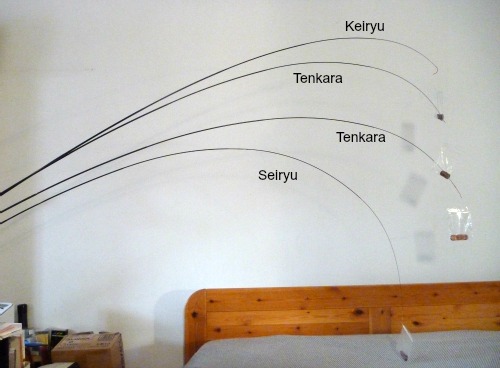
Keiryu fishing is translated as mountain stream fishing. Keiryu fishing and tenkara fishing are both done in high gradient mountain streams and both target the same fish. With an unweighted fly, tenkara fishing is largely limited to the top few inches of the water column. If there is a plunge pool you can use the plunging water to pull your fly deeper, but without one you can only cast further upstream, giving your fly a bit more time to sink. An unweighted fly is just not going to sink very far, though.
Keiryu fishing, on the other hand, utilizes split shot so it is quite possible to fish just off the bottom, whether in runs or in pools. I suspect that the main reason keiryu rods are stiffer than tenkara rods is that fishing deeper tends to produce larger fish. (Looking at a large number of Japanese websites on keiryu fishing as well as tenkara fishing does suggest that keiryu fishing produces larger fish.) Although many keiryu rods are much longer than tenkara rods, not all are. There are 2.7 meter keiryu rods, and even 2.4 - 2.9 meter zoom keiryu rods.
Seiryu fishing translates directly as clear stream fishing, but is perhaps more accurately described as fishing in placid streams, after they have come down from the mountains. In the lower elevations, amago, iwana and yamame are no longer the target species. The fish that do live in the streams tend to be smaller, so fishermen use much lighter, softer rods. One of the more popular target species, oikawa, takes flies readily and people fish for them with flies as well as with bait.
Although keiryu rods are generally stiffer than tenkara rods, and seiryu rods are generally softer than tenkara rods, they do overlap and there is no clear dividing line between tenkara rods and keiryu rods or between tenkara rods and seiryu rods. (At least, not with respect to the action of the rod.)
The four rods in the photo below are different than the previous four rods. They show much less divergence between the tenkara and keiryu rods and between the tenkara and seiryu rods. There are not hard and fast lines between the classes of rods. There are tenkara rods that are stiffer than some keiryu rods and there are tenkara rods that are softer than some seiryu rods.
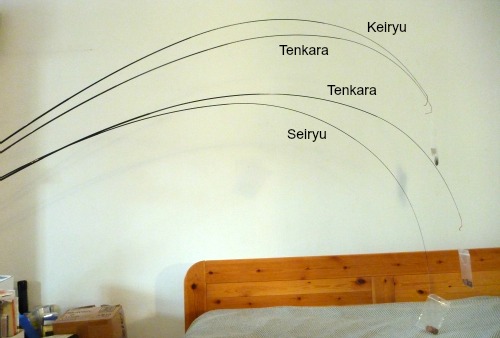
I don't have the necessary equipment to show 30 or 40 or 50 rods at once, but there really is a seiryu-tenkara-keiryu continuum from the softest seiryu rods to the stiffest keiryu rods. One point which rod builders will tell you is that with the right line you can cast a fly with any rod. The keiryu rods pictured above will cast a size 4 or 4.5 level line with no trouble, and will do really very well indeed with furled lines. The seiryu rods will do well with a size 3 level line and just come alive with a size 2 line. The dynamics of the rods are such that you can even cast the size 2 line when it isn't a dead calm day. I am truly disappointed that Sunline no longer makes the Hi-Vis orange line in a size 2. It would be a perfect match for the softer rods.
Shortly after I'd gotten both a Yamame and an Ayu, and could thus compare the range of tenkara rods then available in the US, I decided that the way to choose a rod was based on the size of the fish you expected to catch. As people here and there reported some surprisingly large fish caught on the Ayu, I gradually changed my mind and decided that the way to choose a rod was based on the length of the rod and the width of the stream. Now that I have been buying rods from Japanese companies (seiryu and keiryu rods in addition to tenkara rods), and realize that from the major companies, any given rod model comes in different lengths (which would be like being able to buy an Ayu or Yamame in anything from an 11' length to a 14.5' length) I am coming back to my original thoughts.
Length is still important with respect to matching the rod to the width of the stream but because a wide range of lengths are available for any given rod, matching the rod to the size of the fish you expect to catch again takes on a major importance (at least if you want the fish to be able to put a good bend in the rod). I distinctly remember the very first day I fished with my Yamame. I had hiked into a tiny little stream in the Catskills and caught a bunch of little wild brookies. The biggest one might have been 4 inches long. The Yamame was overkill (maybe overoverkill).
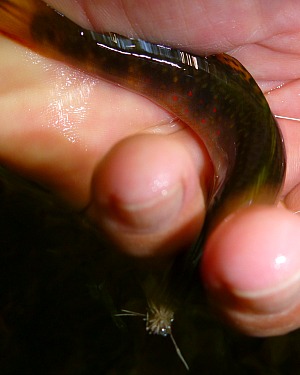
I didn't know then but I do know now of a rod that is perfectly matched for little headwaters brookies. It shouldn't surprise you to learn that it's a seiryu rod. (It also shouldn't surprise you to learn that I'll have some available for sale before long.)
Very recently, there was a thread on a tenkara forum that showed a number of golden trout that a few tenkara anglers had caught. They look like they are all about 5 or 6 inches long. I was lucky enough to fish for goldens a couple years ago, and that's how long the ones I caught were.
The perfect rod for 5-6 inch fish? I have to tell you, a tenkara rod is too much rod. Without doubt, if I had it to do again, I'd bring a seiryu rod. A seiryu rod is to your average tenkara rod as a tenkara rod is to your 5 weight. It gives a whole new meaning to ultralight!
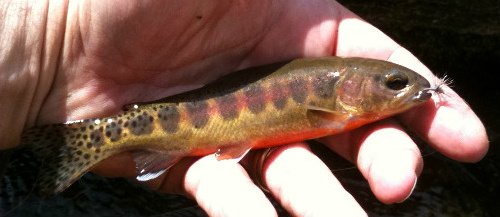
I would not by any means say that seiryu rods were just for trout. There are large stretches of the country where there are no trout streams. There are streams all right, and the streams have fish. They just aren't trout. Many of the streams hold one or more of the many varieties of sunfish. Over the last couple years, people have started catching these scrappy little fish with tenkara rods. Well, let me just say they are a lot scrappier when caught on an even lighter seiryu rod than they are on most tenkara rods.
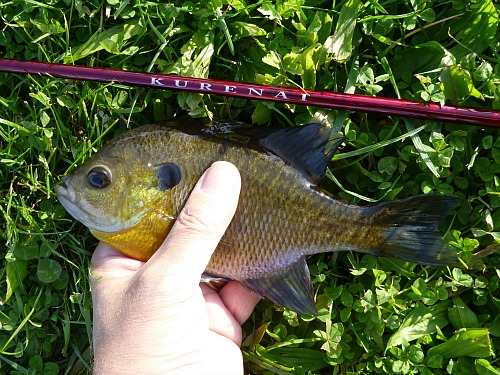
For that matter, there are a lot of fish that almost no one ever fishes for - the people who do catch them tend to do so when fishing for something else. With the right rod, though, they actually put up a pretty good fight! It's all about matching the rod to the fish.
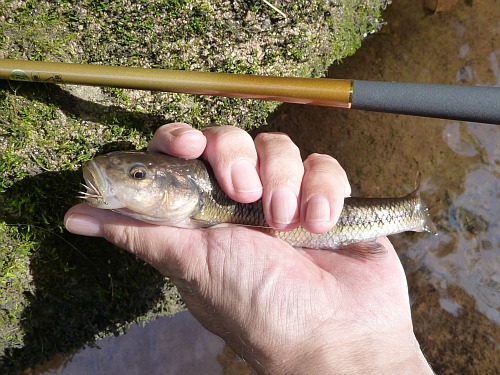
Matching the rod to the fish works at the other end of the spectrum as well. We've all seen photos of large fish caught on tenkara rods, but tenkara rods really aren't the best tools for catching larger fish. I've written a bit about tenkara rods being a bit too soft to fish heavily weighted nymphs effectively. For larger fish and/or heavier flies, a keiryu rod would be a better choice, but that's for the Seiryu-Tenkara-Keiryu Continuum Part II.
TenkaraBum Home > Rods > Seiryu-Tenkara-Keiryu Continuum
“The bitterness of poor quality remains long after the sweetness of low price is forgotten” - Benjamin Franklin
"Be sure in casting, that your fly fall first into the water, for if the line fall first, it scares or frightens the fish..." -
Col. Robert Venables 1662
As age slows my pace, I will become more like the heron.
Warning:
The hooks are sharp.
The coffee's hot.
The fish are slippery when wet.
Beware of the Dogma
If you enjoy spin fishing or baitcasting please visit my sister site Finesse-Fishing.com.



